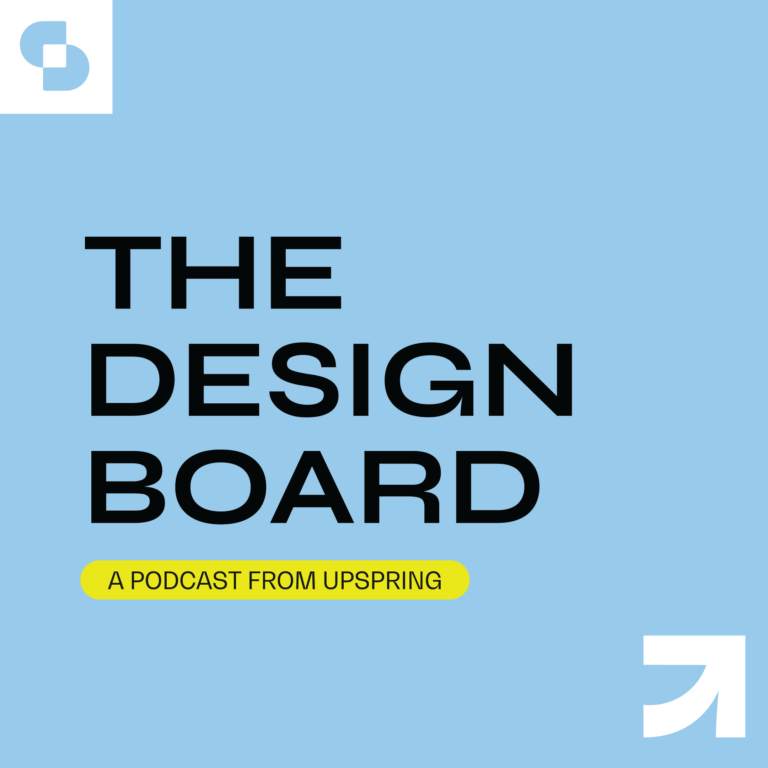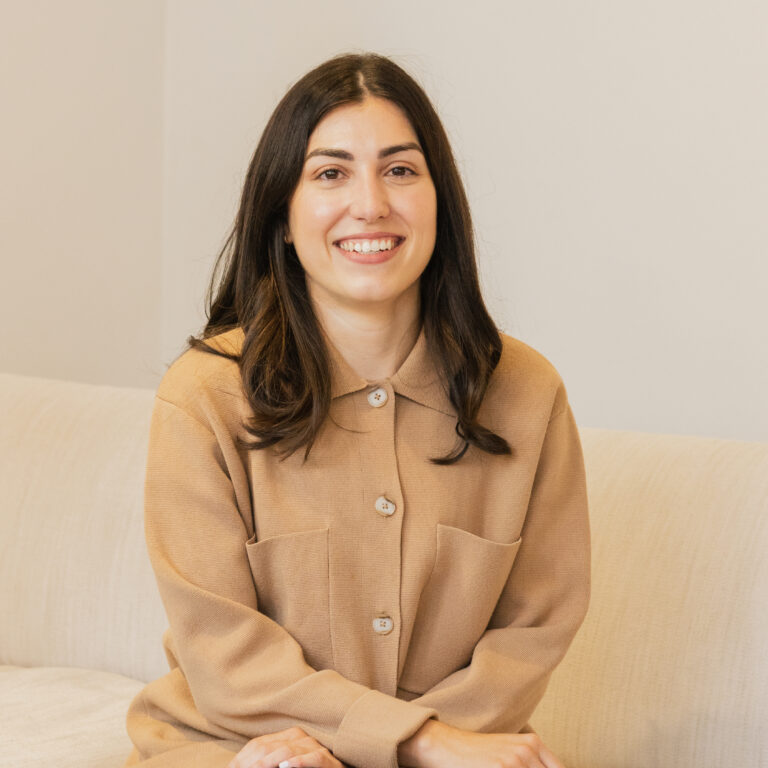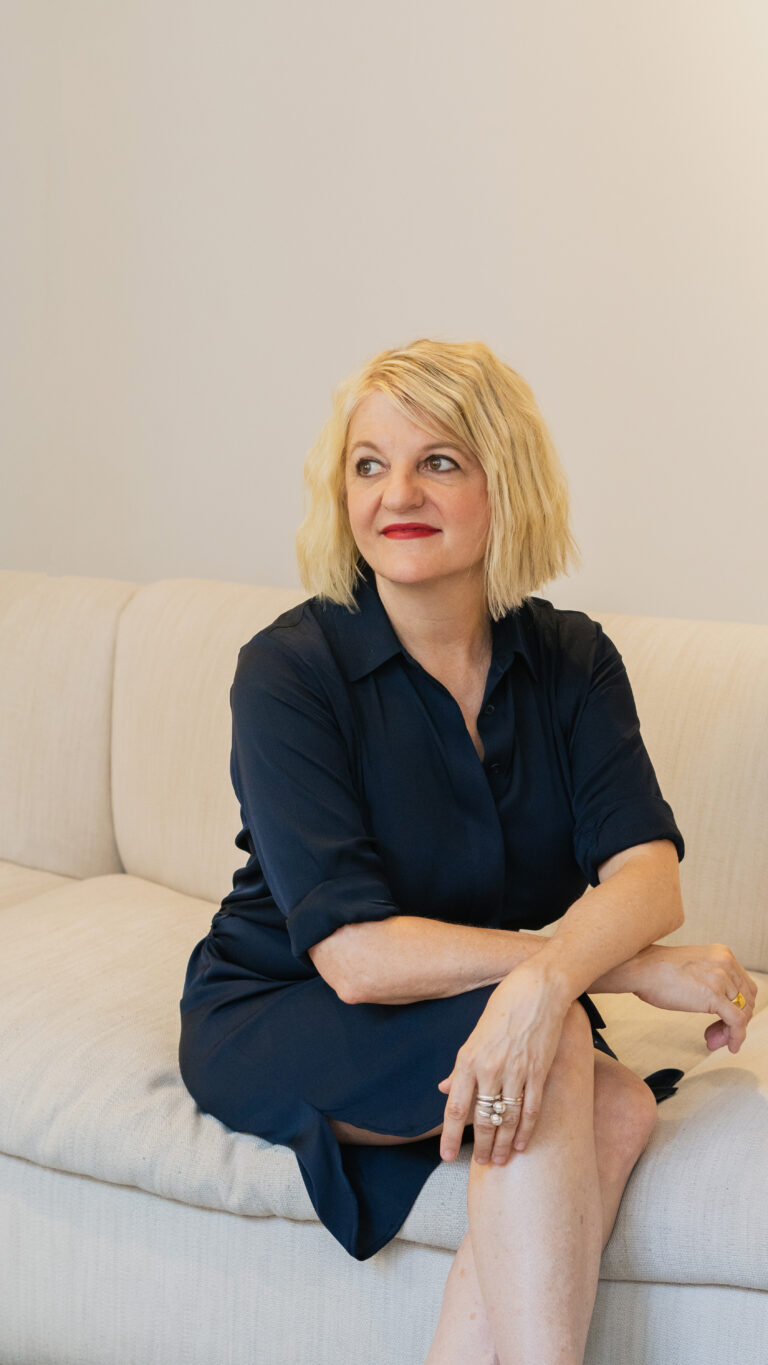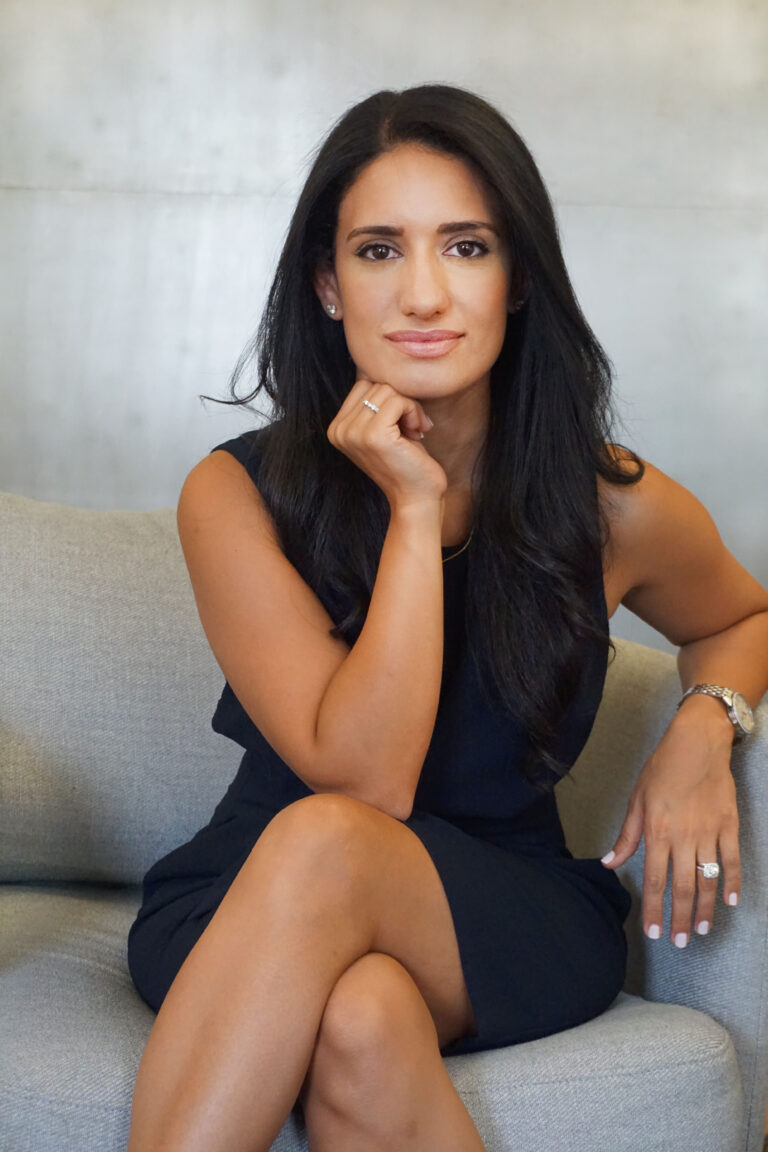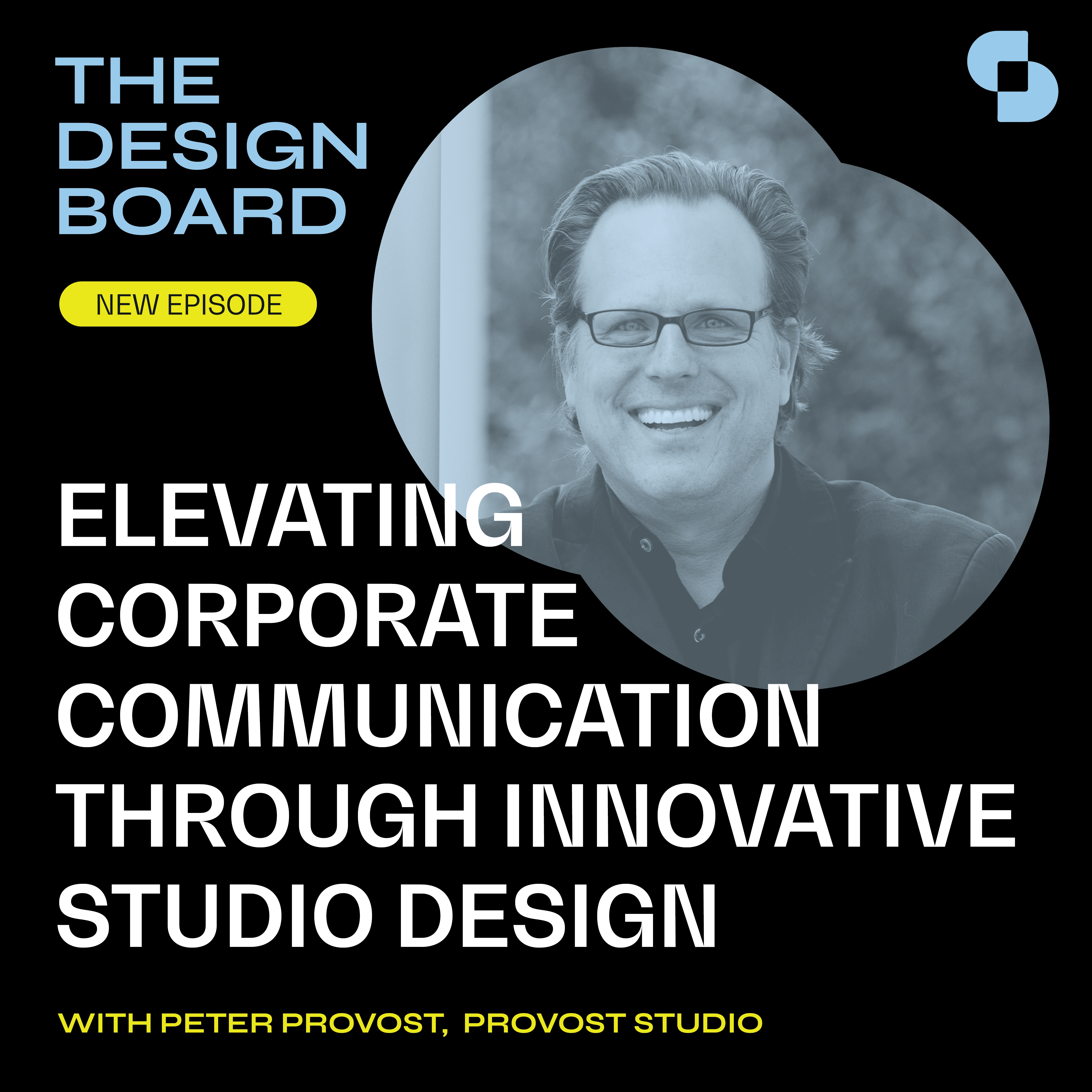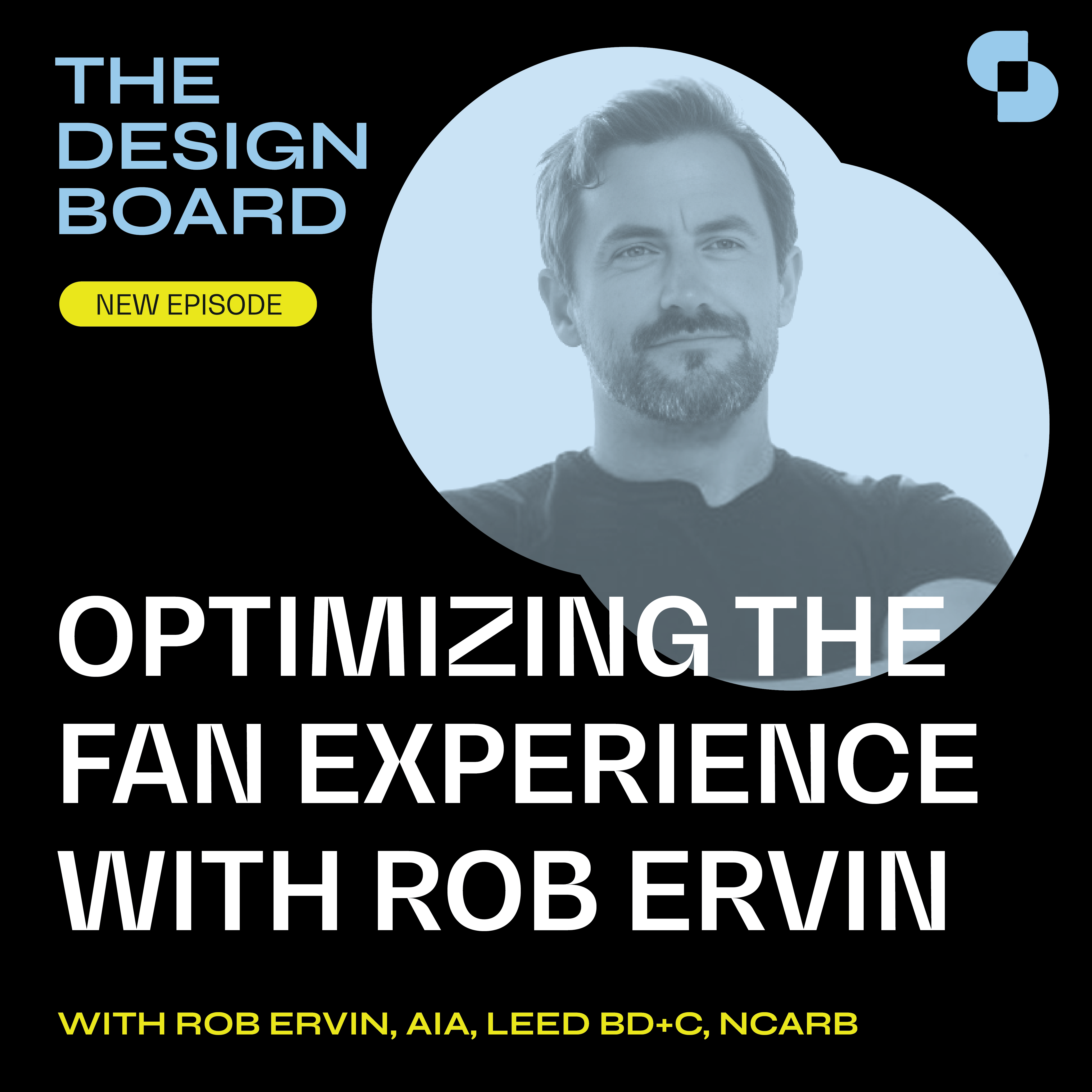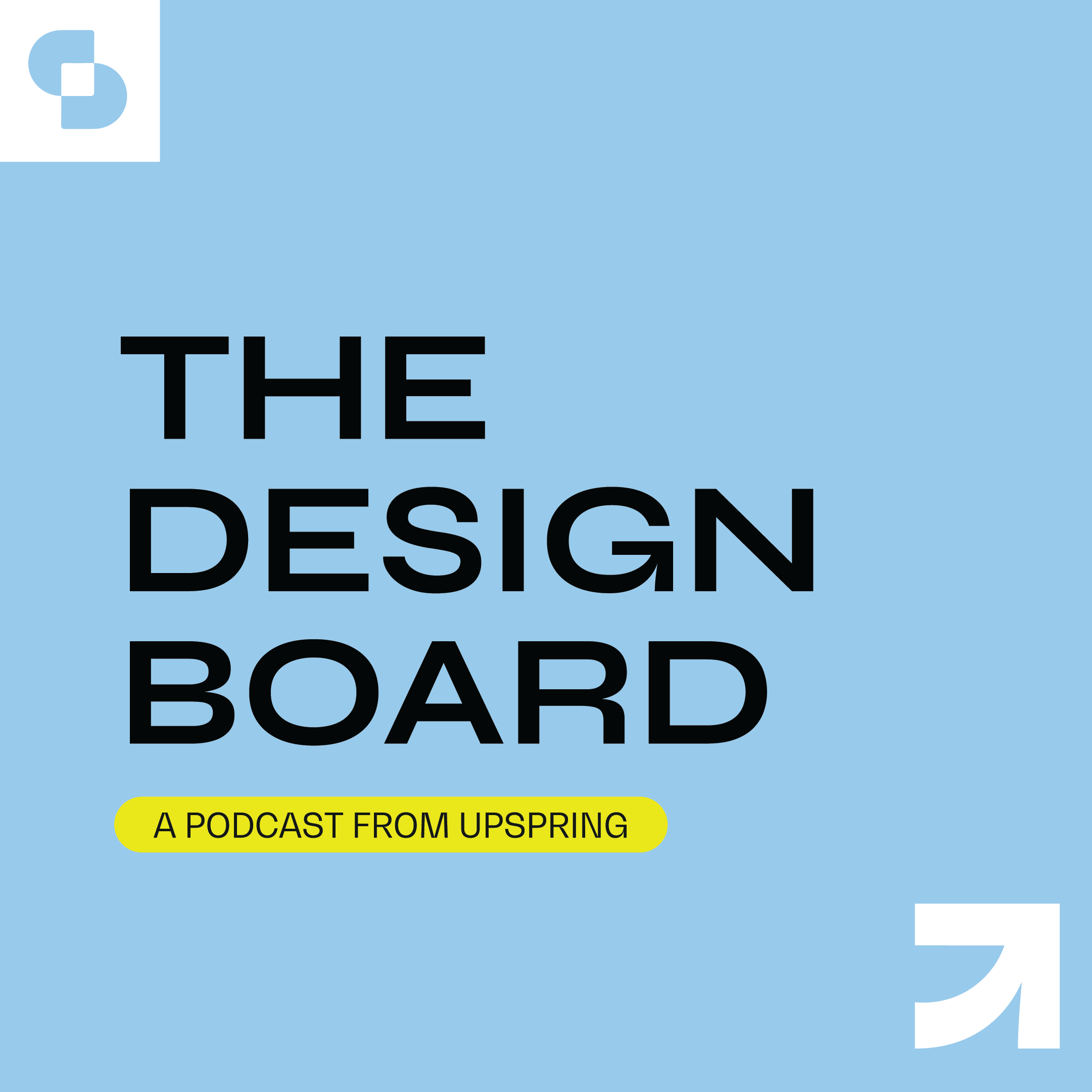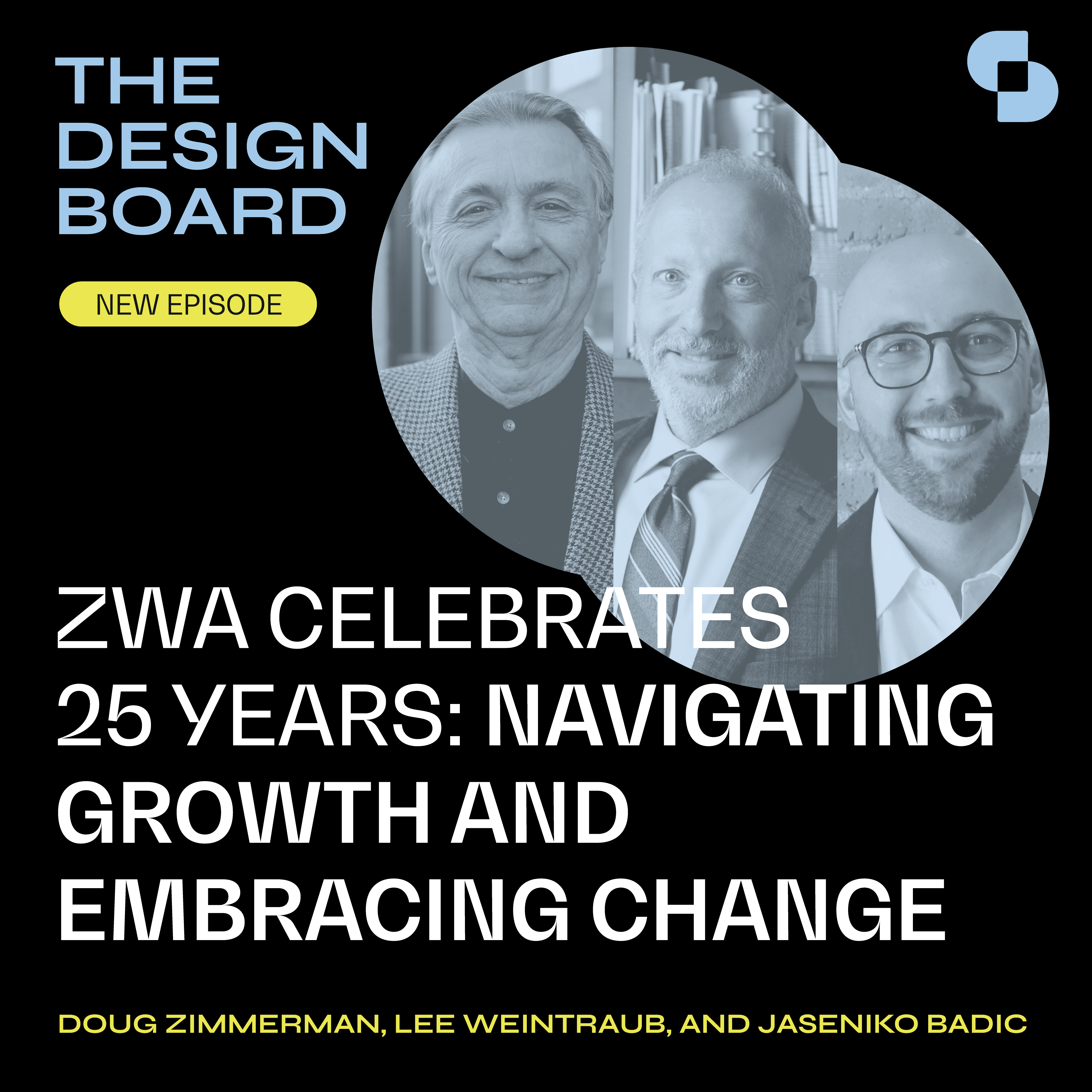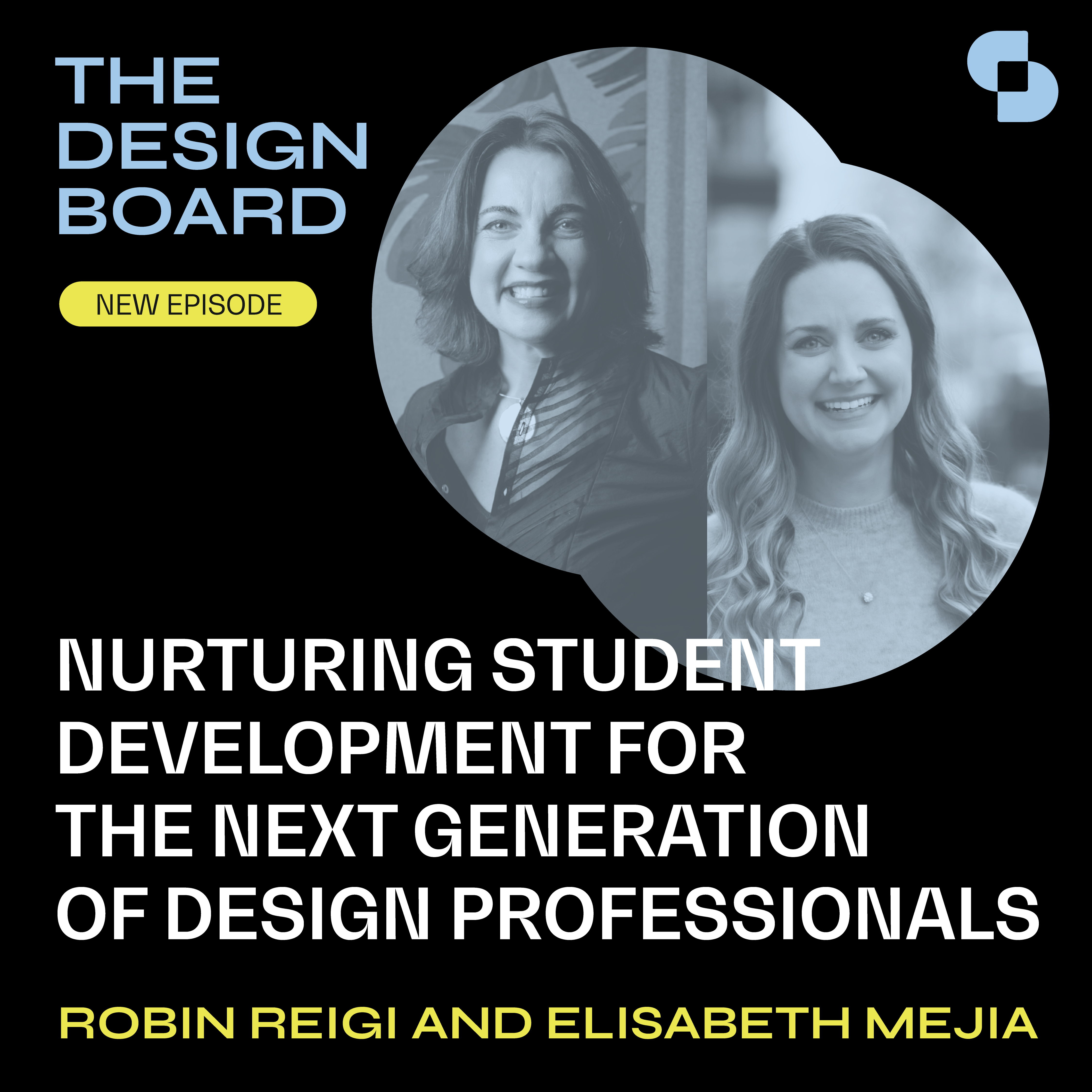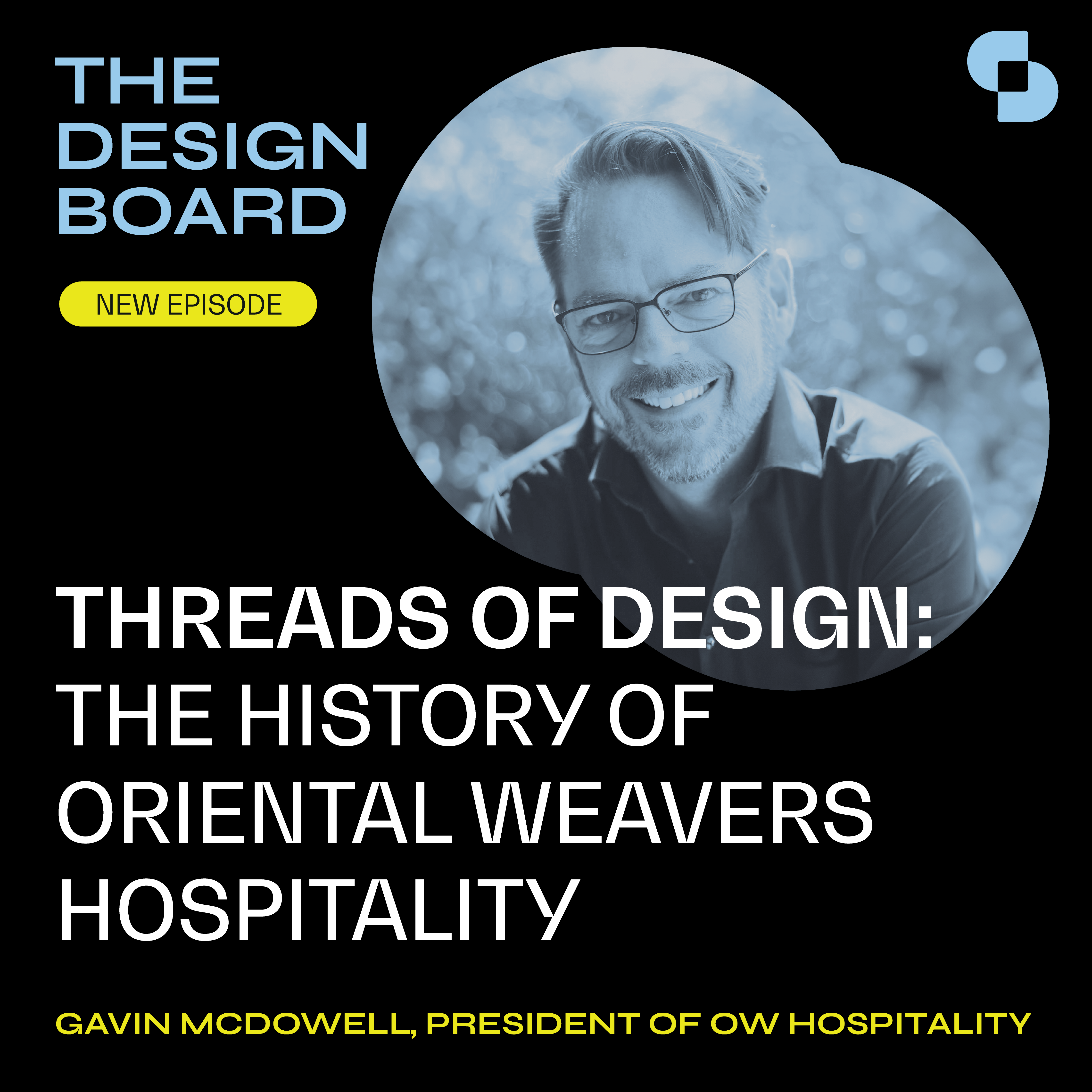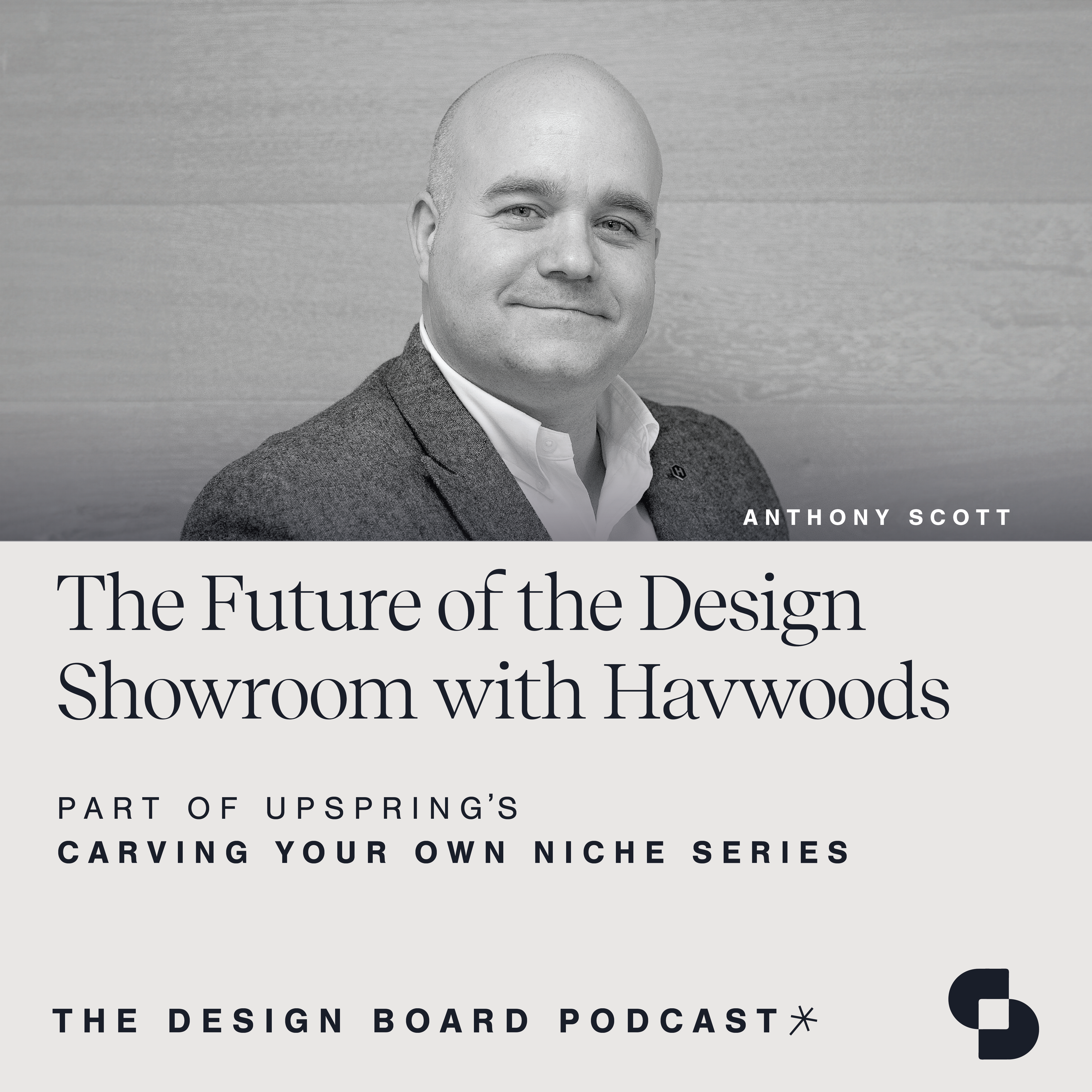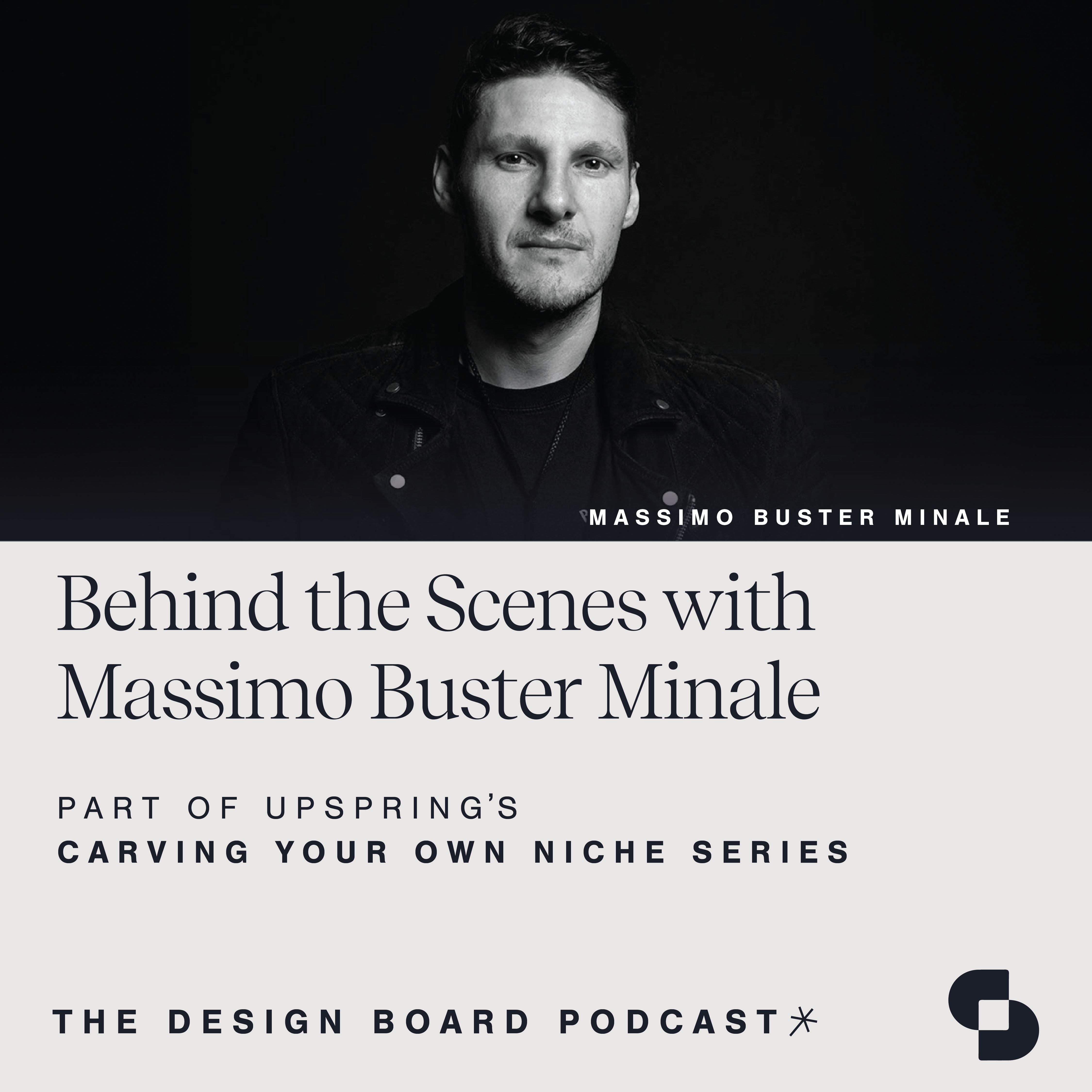In this episode, Nicole Lashae Ben, Design Strategist and C.E.O. of Thrive In Design, shares her incredible journey from working with renowned interior product brands to establishing herself as a prominent figure in the industry. Discover the secret sauce behind her success as Nicole unveils A.C.E. The Journey, her proprietary method designed to transform interior product companies. Learn how this innovative approach addresses the unique needs of the market, providing comprehensive solutions for sales teams and enhancing customer understanding.
The Design Board, by UpSpring, is a proud member of SANDOW Design Group’s SURROUND Podcast Network, home to the architecture and design industry’s premier shows.
Although the transcription is largely accurate it was generated in part by an automated service. In some cases it is incomplete or inaccurate due to inaudible passages or transcription errors.
Speaker 1:Welcome to The Design Board, a podcast created by the team at UpSpring that focuses on design, development, and everything in between. We invite innovators in our industry and explore topics that support your growth in every way. The Design Board is a proud member of SURROUND, a podcast network from SANDOW Design Group, featuring the architecture and design industry’s premier shows. Check it out at surroundpodcasts.com.
Susan Fernandez:
Welcome everyone to The Design Board, a podcast by UpSpring that focuses on design, development, and everything in between. We host innovators in our industry and explore topics that support your growth in every way. I’m your host Susan Fernandez, and today I’m joined by Nicole Lashae Ben, design strategist and CEO of Thrive In Design.
Nicole understands the importance of building authentic connections in the design community. And in today’s episode, we will share her take on design thinking and the importance of having a human-centric sales approach with interior products.
Over the last 10 plus years, Nicole has worked with top interior product brands, including Cambria, Koroseal, USAI Lighting, Lamin-Art, and Lee Broom. Through her work with these brands, she has developed and implemented sales strategies that have generated over 15 million in sales and won over two dozen sales awards.
In 2021, Nicole rebranded her consulting business as Thrive Design, a design and innovation consultancy that helps interior product companies increase their brand awareness and revenue through their proprietary method called A.C.E The Journey. Nicole noticed two needs in the market. A lack of training for sales teams, and a need for more understanding of the customer journey. Thus, by using A.C.E The Journey, Nicole can create training, coaching programs, and strategic planning through a collaborative experience with her clients. Nicole, we’re so thrilled to have you. Welcome to the podcast.
Nicole Lashae Ben:
Thanks so much for having me. I’m excited to be here.
Susan Fernandez:
Well, you really are doing something in the industry that is so desperately needed. Can you start by sharing your journey in the design industry and how you transitioned from working with top interior product brands to becoming the CEO of Thrive In Design?
Nicole Lashae Ben:
Yeah, for sure. So for me, it really all started back in undergrad. So I studied interior design at Syracuse University, go orange for anybody who’s out there listening. And interior design for me was more than just the built environment. The part that I loved about design school was all of the project prompts that they gave us, which sometimes involved them just giving us something random like choose a world issue and design a concept and a space to become a solution for that.
So I really became in love with interior design, as well as the design process, design thinking, and how it can be used to understand people, their pain points, and then create innovative solutions to solve those pain points. And so that love for design thinking and the design thinking process led me to go onto grad school at Savannah College of Art and Design and get my master’s in design management. And then all the while, I was also working for these interior product company brands on their sales teams all along.
But I am a problem solver by nature, and I’ve been a problem solver all my life. So in working in different sales roles, yes, I was selling. Yes, I was achieving the sales goals that they set for me, implementing strategies. But I was always thinking, “How about we do this better, and create different solutions along the customer journey for us to increase brand awareness, to consult designers better, and then ultimately increase our sales?” And I found that my passion was more so in solving those problems in how we’re going to sell better, rather than actually being on the sales team. So I ended up creating my own company that did just that. I wanted to go into companies, find all their problems, and collaborate with them to create strategic solutions.
But my company didn’t start as that. It didn’t start as a focus on interior product companies. Initially, I was just working for those brands and I was like, “I know I want to do something outside of this. I am not fulfilling everything in my roles at a company.” So I started my brand as Nicole Lashae Consulting, and I was like, “I’m going to do something design thinking. I’m going to do something that pulls all this stuff together, but I don’t know what.”
So that’s why initially I started as Nicole Lashae Consulting, and I was actually consulting tons of different types of company. Beauty brands, other consultants and coaches, product-based businesses, service-based businesses. And it wasn’t until I rebranded in 2021 as Thrive in Design that I started to focus on the niche that I worked in and I went to school for. So that’s kind of how I got to where I am today.
Susan Fernandez:
So that’s really interesting, Nicole. It sounds like you had the view at 20,000 feet, could really look at the sale and the way that the entire industry was approaching that sale, and then come up with a system to really better serve both the designers and the manufacturers. So you call this A.C.E The Journey. Can you tell our listeners more about this approach, and how it really is tailored to address the needs that you saw in the market?
Nicole Lashae Ben:
Yeah. So as I said before, my passion has always been in design thinking. And with design thinking, there’s a lot of different tools that you can use in order to understand your customers a little better.
One of those tools is a journey map. And with journey mapping, you’re basically mapping out everything from start to finish with your brand that a customer might experience, or even before they get in contact with your brand and after they purchase something. So journey mapping is a tool for you to better understand that whole customer experience and whole customer journey.
So as I was trying to figure out, how can I make a journey map relatable to interior product companies, I really brainstormed a lot and did some research. But I wanted to break it down in a way that people can remember it and it’s easily understandable.
So A.C.E The Journey, A.C.E is actually an acronym that applies to how you can use a journey map from the lens of an interior product company. And ACE is the acronym for three different research questions that I always focus on when I’m working with my clients.
So A is, how is your brand appearing in the market? C is, how is your brand consulting designers. And then E, how is your brand executing a sale? And so within each of those parts, that will basically map out the whole customer journey, mainly from a designer’s perspective. And you can dive deep into auditing all of those different parts to see where are we losing designers, where are they not aware of our brand, where do we need to tighten things up so that we don’t lose the specification to our competitors, and different things like that. So that is basically the journey map that really any interior product brand can apply to how they’re approaching sales in their company.
Susan Fernandez:
To do that is that you’re a consultant. Are you doing ridealongs with sales folks? Are you interviewing designers on behalf of these product companies? Can you just give us a little insight into what that looks like if someone wants to work with you?
Nicole Lashae Ben:
Yeah. So for the most part, it’s been super high level of what I’m doing. So say for instance, a company is coming to work with me. We’ll first start by auditing that whole customer journey. The appearing, consulting, and executing. And that might look like interviewing their internal team. That might look like observing, that might look like having a collaborative workshop to map out what their whole customer journey looks like. And then we’re identifying pain points within that.
So the pain points might include interviewing some designers that they might work with at some of their A, B, or C accounts to get an understanding of what works well with working with that interior product company, what does not, and getting feedback, and then offering some insights and strategic solutions.
And I’ll get into it as we get further into this interview. But essentially, the main thing that I’m doing is I’m going in and auditing that whole customer journey, mapping it out from start to finish. And then offering, “Okay, out of the research methods that we employed,” whether that’s observations, interviews, or just a collaborative workshop, “These are the insights that we’ve seen come up over and over again.”
Sometimes, is that they need to have some strategic solutions within their appearing stage, and the ACE in that ACE journey. They need to revamp their marketing materials. They need to come up with a sales funnel that attracts customers on social media and then gets them leads that they can then funnel to their sales team.
I was at a trade show a few weeks ago prospecting some new clients. And a lot of people that I met, they needed to work on their booth design. Because they were selling mirrors in their booth, but people were walking by them because you couldn’t even see the mirrors. The mirrors were laying down on the table. So it might be creating some strategic insights on how you can better attract people in that point in the customer journey when you’re at your trade show.
So we look at a whole lot of different points of context within that awareness stage, but also as you go through the consulting and executing to make sure that people don’t overlook your brand, don’t forget about it, and don’t just switch you out of the spec because you’re not optimized, I guess, in your sales process.
Susan Fernandez:
Interesting observation to make. And one that I think when we’re in it, when we’re the people who are exhibiting at the trade show, it’s really hard to see how we appear from the outside. It seems like you have honed sales strategies, and the proof is you’ve been able to generate over 15 million in sales, and won over two dozen awards, which are really impressive results. So can you give us some insights into what these key principles or strategies are that have contributed to your success?
Nicole Lashae Ben:
Yeah. I would say the main two things for me, especially when I was working for interior product manufacturers, was social selling and sales funnels. So at the time that the height of the pandemic first hit, I was working for Koroseal in sales, and at that point I was already about a year and a half into entrepreneurship. So I was very well-versed on not only A&D sales, but also how I could apply what I learned in entrepreneurship, and marketing, and online sales funnels, and social selling into what I was doing in A&D sales.
So while the world was panicking and the industry was like, “Oh my gosh, we’ve only been selling person to person by making sales appointments through going to design firms and meeting with designers,” I was like, “I’m just going to keep doing what I’m doing,” right?
Because for me, in social selling, it was all about creating one, an online presence, creating authentic relationships online and offline, attracting customer leads, nurturing those leads through my online presence, and then ultimately consulting those designers through a series of consultative approaches that I typically have.
So as the world panicked, as my company panicked, I was just like, “I’m just going to keep doing what I’m doing and use these social selling tactics, bring people into an online sales funnel, and keep doing what I’m doing.” And so for me, that was really easy, even before the pandemic. And it was easy to connect because most of the specifiers are millennials and Gen Z, so I was just like, “Let me keep going.”
So fast forward, my company at the time was like, “Hey, Nicole, what is this automation that you have set up? What is this thing that you have in your email signature? How are you doing this? How are you creating content? How are you going live? How are you funneling people, and keeping people engaged, and not going down on the sales goals that we have set for you, even though we’re in the midst of a pandemic?”
And so now we’re in this post pandemic, and I put that in air quotes, because I don’t know what stage of the world that we are in. But we’re in a place where, yes, the world is back open, people are back in their office. But essentially, a lot of design firms are still hybrid. Most specifiers are still millennials and Gen Z, and prefer asynchronous communication, asynchronous collaboration. And they also prefer to have these authentic connections that you’re building through social platforms sometimes.
So for me, it’s really about leaning into that and helping companies realize that’s going to be a big part of it, and that’s not going anywhere. So how can we leverage social selling for your team, teach them about it, and then also create these digital experiences that mesh together that online and offline experience?
Another example of a company that I was prospecting the other week at this trade show… Actually the mirror company, let’s use this mirror company. They had the mirror down on their table so you couldn’t see it. And then they also didn’t have information that was easily accessible.
So my off the top recommendation was, how can somebody take information away from you at this trade show? Implement a QR code that leads people to some type of enticing information that shares your brand story, leads them to know who their rep is, and then get in contact with them right away, and leads them to know how to specify.
So that’s a combination of all of those things. But first, for that specific example is how they’re appearing to that designer in the physical space and then connecting with them in this social way that also integrates an online experience. So that has really been the magic sauce, but it’s different typically for every brand on what you would implement to work well.
Susan Fernandez:
In the case of Koroseal, and you’re being able to grow sales and hit your sales targets, and I’m sure exceed those during that time, it occurs to me something that I see a lot in the market where the sales rep is left to put together their own marketing tools, and the brand is sort of sitting outside of that. And your success is based on how well the market. But you and I know there are a lot of really great reps who maybe are not as technologically savvy, who don’t know how to build an automated campaign.
So that is really, I think one of the things that the pandemic showed us was that we really have to reach all of our customers where they are. And that’s brilliant that you were able to do that.
Nicole Lashae Ben:
Yeah. And if those companies still don’t know, that’s when they can come to me.
Susan Fernandez:
Yeah, no, I think this is great because as sitting where I sit in PR and marketing, we can help a company when they’re ready. But if they don’t understand how to sell, and it’s shocking how many don’t, that there’s really nothing that you can do to convince them that, yes, we’re selling now to [inaudible 00:16:33]. Even though when the owner of that company walks in a firm, they’re talking to the principals. Principals aren’t specifying, you need to talk to the people, the actual boots on the ground, and they communicate in a very different way.
I love this idea of building authentic connections in the design community. It’s a theme that you really emphasize. So how has this focus on building relationships influenced your approach to design thinking?
Nicole Lashae Ben:
So I wrote down the definition of design thinking before we got on here, and I always lean into IDEO. IDEO is probably the biggest design consultancy in the world, and the pioneers and design thinking. And everything they do, I eat it all up. But on their website they say, “Design thinking is a human-centered approach to innovation, anchored in understanding customer needs, rapid prototyping, and generating creative ideas that will transform the way you develop products, services, processes, and organizations. By using design thinking, you make decisions based on what customers really want, instead of relying on historical data or making risky bets based on instinct instead of evidence,” especially leaning into that last part.
So a lot of the times, especially when I first started my business, I find that companies will just come up with the idea of what they think their customers want, rather than learning what their customers need, and then creating solutions based on that. And that’s when products or the strategies are how you’re bringing it to market.
So when I think of authentic connections, and something that I’m leaning into all the time, it’s really leaning into building authentic connections with the people who you are serving, whether that’s the designer, the contractor, the purchasing agent, the office furniture dealership. Whoever it is that you’re serving, you need to build authentic relationships and connections with them so that you can truly understand what are they struggling with, how are they specifying, why aren’t they specifying? Who are they leaning into as your competitor? Why is that? How is that competitor serving them? How are they connecting with them? And when you create more empathy in their experience with your brand or your competitors, then you can ultimately design solutions that lean into just that.
And that could even go back into the product development stage. I’m not well versed in product development, but of course as you create those authentic connections, and really understand your customer needs and desires, then you can create solutions for that.
And that really goes across the board any industry. One example I always like to think of in terms of Apple Music or just Apple products in general, it’s like I know when I was growing up, I was always carrying around literally a CD player and then a case of CDs. I would carry around 30 CDs and this CD player. And if you’re looking at that from a design thinking perspective, people are looking at, “Okay, all of these people are walking around with all of these things in their hand,” and you’re thinking, “All right, those are the humans that we’re centering. How can we take that away or make the music experience digital where they don’t have to carry all these things around where they can put 1,000 songs in their pocket,” of what Steve Jobs created with this product.
The same thing goes for authentic connections in the interior design industry, interior products. How can we look at their process and how they’re experiencing your brand right now, or your competitors, or just a specifying process in general? What are the trends? How can we understand that and empathize with them in that process, and then create better solutions to give that same experience of having 1,000 songs in your pocket so you’re not carrying around a Walkman and 30 CDs like me, like 10 year old Nicole. So that’s really what that comes from.
Susan Fernandez:
Because the next question is about this human-centered design approach, which I feel like you’ve answered it, but I’m wondering if what we’re talking about is brand positioning in a way. So I just want to make sure that I’m clear on this. And so maybe the next question which I’m on is five is relevant, or if you feel like you’ve covered most of it, if there’s anything specific.
But it sounds to me like there’s two kinds of issues you’ve identified. One is that sometimes products are just made in a vacuum based on data. “Well, they wanted more red, but what they don’t understand is they’re looking at a data point and it’s leading them to make an assumption on the product.” But then it’s also, this human-centered sales approach is very much about knowing your customer and knowing what they need. But then where I see companies get tripped up is, “Well, that’s just Dini at Marriott who needs that. That’s not this other person.”
So I guess my question is, if I was to look at this, and this question that we have coming up next, and modify it a little bit, it would be how the concept of centered sales approach with interior products is intriguing. Could you tell us more, and walk us through this approach, and how digital fits into it? Does that make sense?
Nicole Lashae Ben:
Yeah.
Susan Fernandez:
Because I don’t want to just talk about relationships, because everyone in sales just talks about relationships. But you’ve found this magic of really knowing the customer, and then figuring out smart ways to reach them that feel really personal, but sometimes are automated. I don’t know. Am I confusing it or-
Nicole Lashae Ben:
No, no. I can give a couple examples. I wrote a couple examples down.
Susan Fernandez:
Okay.
Nicole Lashae Ben:
So let’s go into A.C.E The Journey again. So again, A.C.E is the acronym that you’re going to break down for any interior product company. How is your company appearing in the market? How are you consulting designers? How are you executing the sale?
Now, if your consulting designers is more so the consultative approach and the relationships, and most people can really lean into that, especially if you have a good sales team. When it comes to executing the sale, that’s really taking an internal look at all of your sales teams. How are you collaborating? How are you talking to each other? How are you bringing that sale that you work two years on across the finish line so you don’t lose it, right? Most companies are doing an okay job at that. It’s the appearing stage, especially when it comes to integrating digital into it, that most companies are struggling with. So when it comes to appearing, I typically break it down even further into very specific categories. So it’s typically direct contact and indirect contact.
So direct contact in the appearing stage of that customer journey is typically when a designer needs direct contact with a person at your company. Indirect contact is when a designer is in contact with your company, but they’re not in contact with a person.
For example, the SEO, they search something on the internet. And then because your website is search engine optimized, they come out onto your website. Or now they’re on your website and they have this brand experience with your website, they’re adding things to their cart, they’re checking out. Or maybe they’re even on material bank, and your company is there, and they get in contact with your company there. Or it’s social media campaigns that are run through either your company social media accounts and/or your sales reps social media accounts.
So there’s several different points of contact that a designer can come in contact with you. So it’s either through direct contact, directly with a person, or indirect contact that does not need a person for them to learn more about your brand or maybe shop your collection. So let’s break that down even further into the trade show example. And we’ll go back to that example of the mirror company that we were using earlier in this episode.
So if we’re thinking about this mirror company and how is this company appearing in the market, and the one point of contact that we’re going to audit is a trade show that they appear at, they have direct contact because they have a person in that booth that is coming to talk to designers. So the experience that a designer have might be they come into the booth, they see the product, they learn more about the product, but they also need to maybe see themselves in the mirror. Maybe there’s a campaign that you create about feeling good or feeling confident, that you have, hashtag feel confident in X, Y, Z mirror company or whatever it is. Maybe there’s a campaign so they can understand the brand story, and how that ties into feeling confident, or the lighting, or how the lighting makes them look more beautiful in the mirror. And then they’re like, “Okay, yes, this is memorable experience. So how am I going to take this away with me?”
In comes digital. So digital can happen in two ways in that booth. You’re scanning their information and then you’re putting that into some type of email marketing campaign automatically for everybody who comes to your booth. And then the email marketing campaign follows up with them immediately like, “Hey, thanks for coming to my booth,” the day after. “Hey, remember you saw the feel good in X, Y, Z mirror campaign and the thing? We’re prompting you to share what makes you feel good when you look in the mirror on social media. Use the hashtag and tag our brand.”
So now they’re sharing it on social media. The rep might see it, the brand might see it, they continuously engage. And then ultimately, hopefully that leads to a meeting for them to talk about a project where they can use that mirror. So that’s one thing. So that’s the brand automatically engaging through them, scanning their information, and having some type of digital automation set up.
The second thing that can be taken away is for that person to take some type of information right away. Is there a QR code that that person is scanning where they can get a digital flip book, or download a spec sheet that they can send off to their junior designer that’s back in the office, that wasn’t able to be a part of the trade show? Are they able to scan a QR code and get their rep’s information right there, and save their rep’s phone number in their phone?
So there’s so many different options, but it started with that designer coming to this physical touchpoint or direct touchpoint with this brand at the trade show. And now, the brand can put these two different options of digital contact with them in order to, again, lead to a physical meeting hopefully.
But that’s just one example of how you can blend that physical connection with a digital connection, then that leads to physical without just being like, “Hey, we’re here at this trade show booth. Look at our mirror that’s laying on the table,” and hoping that somebody walks by, looks down at the table, and then specifies it, and they’re, I don’t know, 100 guests from hotel. You want to think of, “All right, how can we capture their information and then recapture their attention after they walk around this whole trade show and see thousands of more booths, and integrate digital experiences in that?”
Susan Fernandez:
Well, clearly, if this mirror company did not hire you, they should.
Nicole Lashae Ben:
Right.
Susan Fernandez:
An incredible example. And I always think of all the beautiful print material people put together, and then it’s sitting in the wastebasket of a hotel room as we decide what we’re going to pack as we leave. So really having a strong digital component is so important.
So Thrive Design not only offers consulting, but also training in coaching programs. And I know there is just such a big need for this. So can you share some examples of how these programs have made a difference to your clients in the industry?
Nicole Lashae Ben:
Yeah. So most of my work is in consulting, in auditing, giving insight, strategic planning, and then helping those companies implement the plans that I come up with. The training and coaching is definitely still growing, but people can hire me for basically two tracks.
If an interior product company just made a new hire, and that new hire is coming from a completely different industry, and I see it happen all the time, they’re coming from sales but not in A&D sales. So I can go in and basically train that person or train that team. “Here’s the basics of interior design, how to read a plan,” because that’s very important when you’re a sales rep, how to read those renderings, and then take all of that information to create strategic recommendations to the designers based on your product offering. So that’s one option I can help with.
And then the second one is when a company is like, “Okay, we actually need help with social selling and how to leverage it for our sales team.” So I can go in and have a specific training on social selling, and then do either one-on-one coaching or group coaching to help the not so tech-savvy people implement some things for themselves. So those are the two different tracks.
But one client that I have specifically is a furniture company, and this is a residential furniture company based out of Phoenix. And they have been in business for 18 years, and they were switching from doing custom furniture made to order to doing a collection of furniture. So they needed a couple different things on the consulting end, but they were also expanding their sales team, and everybody on their sales team was coming from a different industry, no design background, no A&D sales.
So what I did was did a series of workshops for their sales team, and then set up a group coaching session once a month so their sales team can come in, and ask questions, and then I’d go over things to review with them so that they are successful in implementing everything that I help them with their workshop. And that actually started earlier this year, and they’ll be launching their collection next week. So hopefully we get some good feedback from them.
But overall, it was really nice to see how confident the team felt in the language and the verbiage that’s used in the interior design industry that’s come second nature to some. But even COM, that’s a term that comes easily to me or to other people who have industry experience. But for people who are not familiar, they’re like, “What is a COM? Is it like a .com?” So I have to get into the nitty-gritty there.
Susan Fernandez:
That’s really important, because there’s a lot of startups in this industry or a company that may do well selling to direct to consumers, and then decides it’s going to create a line for designers, as you’re talking about. Then getting into that is just a massive learning curve. It’s a sale like no other.
As you know, it’s always really hard for us to explain to a company that’s coming to market that you may get written into a plan or specified, but the actual time between that and the installation could be two years, could be three years. So it’s important to have a really highly trained, highly skilled, industry savvy sales team, if you expect at all to make inroads in this market.
As a CEO and design strategist, I’m going to switch gears. You wear a bunch of hats. So how do you balance the strategic aspects of your work with the creative side of design? Because sometimes, they seem to be almost diametrically opposed.
Nicole Lashae Ben:
Yeah. Listen, sometimes I don’t balance well, to be honest. I do wear a lot of hats in my business. Luckily, my team is expanding. Because when I first started my business, it was just me. And I also have a podcast, so I was a podcast producer, the show editor. I was the consultant in doing all of the things, which was really hard. But luckily, my team is expanding, so I’ve been able to make a list of all the things that happened in my business, all the things that are outside of my zone of genius, that don’t actually bring me joy on a day-to-day. It’s like it needs to be done to run the business, but I don’t necessarily have to do it, and then I outsource it.
So I have a couple of people who I outsourced as contractors to a project coordinator, somebody that’s coming on to help me with business development, so that I can have better balance so I don’t have to wear 50 million hats every single day.
And then for the things that I still have on my plate and I’m trying to balance, I just try to block my calendar out as best as I can, and I don’t believe in multitasking. So if I block my calendar out for an hour to do prospecting for new businesses or that are going to be my clients, I am only focused on that. Because if I take my attention away to focus on following up with who’s scheduling posts on social media, then everything goes downhill. So I don’t believe in multitasking, block my calendar, and then outsource as much as I can for my business.
Susan Fernandez:
So what are some of the exciting projects or developments that you are working on at Thrive in Design?
Nicole Lashae Ben:
So I found, especially this year, people have been asking me to do things that were not on my initial list of services. So I’m like, “Okay, let me expand, or pivot, or again, listen to my customers, because design thinking is important to me.”
So a lot of the times, I’ll work with a company and I’m like, “Here are all the problems that you have. Here are the insights and here are the strategic plan.” And if they do have internal support to implement the plan, great. But a lot of the times, especially this year, I’ve been attracting new businesses and solopreneurs who they’re like, “Hey Nicole. Yes, you’ve given me all of these things that I need to do strategically, but can you also help me design the website and implement all of these sales funnels, create the brand design,” or even sometimes do the whole booth design, or their showroom or retail store.
So one thing that I am expanding into in 2024 is offering an interior and environmental design for their showrooms and their booth design. And also, I’ve already started in offering the graphic and web design by bringing on a recent grad from my alma mater to do that.
So one of my clients that I’m starting with coming up is this company called Creo Design Collaborative based out of New York, where I’ll be helping her with her strategy and how she’s going to market, as well as her web and graphic design with one of my upcoming designers.
And then outside of that, one of the things that I’m super passionate about is just giving back to people coming behind me, especially women of color in this industry. So hopefully by 2024, 2025, I’ll be launching a mentorship program for students of color looking to start a career in the interior design industry.
Susan Fernandez:
That is fantastic, because certainly they are underrepresented, as you know. It’s quite shocking sometimes. It really is. So finally, my gosh, you have created it all. You really are running with every aspect and able to do what I think is probably your superpower, which is look at the big picture, but then also somehow focus on the details, and see those patterns. So what advice would you have for an aspiring designer or an entrepreneur looking to make their mark in this world, especially in this realm of which I think is just fascinating, interior products?
Nicole Lashae Ben:
So for me, my journey here, I would say in the last five years seems like a real clear path, but it was a roller coaster post-college up until 2017. So I would say for me, looking back into it, if I was to give advice to my younger self or anybody who is aspiring in this industry, is to really just find the niche in the industry that really lights you up. Even if you don’t know how it’s going to pan out, just find it and identify that it brings you joy, and go after it with everything you have.
If some type of opportunity does not exist within that niche, or you find it very hard to find a job within that niche, because there has been times that I applied for design strategist roles at some of the top consultancy companies or even smaller consultancies, and I didn’t get it, and I’m like, “I know what I have is meant to be out in the world and it’ll be different from anybody else.”
Even when those doors didn’t open, it’s like you still have to go after it and maybe create your own lane. And when you do, it’s about validating, “All right, now that I’ve created this lane, how can I validate the demand that I have in my head?” There’s a demand for what people are looking to do.
And once you do that, just don’t give up, even when you get all the nos in the world, because I still get nos when I’m prospecting companies. They’re like, “Okay, what do you do? What are you trying to do?” Or, “We’re not ready right now,” or, “No, no thank you.” Just hype yourself up in the mirror. Give yourself affirmations and just keep going until you achieve the success that you believe you deserve.
Susan Fernandez:
I love that, because from where I sit, you look totally polished and successful. Like, “One day I just opened the door and there was my consistency.”
Nicole Lashae Ben:
No, no. I’m going to write a book about all the nos, and closed doors, and tears that I cried to get here. And I still haven’t achieved everything that I want to do yet.
Susan Fernandez:
Well, they say what is rejection is God’s protection. So really focuses you to find that… I mean, you are so niche focused and it’s so incredibly needed. This is an industry that is crying out for the types of sales consultative services that you provide, because there really is very little out there. Thank you so much for your time today. You’ve been absolutely inspiring. Thank you.
Nicole Lashae Ben:
Thank you so much for having me. It’s been great.
Speaker 1:
Thank you so much for listening in with us today. We hope you leave inspired by the ideas in today’s episode. For more, follow UpSpring on LinkedIn and Instagram. And don’t forget to check out the amazing lineup of shows brought to you by the Surround Podcast Network at surroundpodcasts.com.

